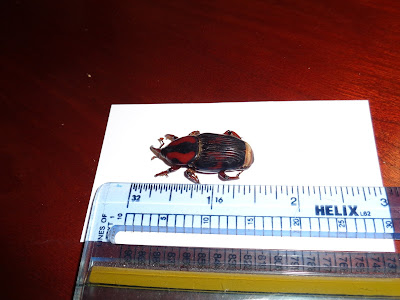“Oh no!” – was I all I could say as I noted the telltale
brown fronds and slightly tilted, leaking canopy. Our prized Bismarck
palm was marked for death as masses of unseen three-inch long palmetto weevil
larvae tunneled inside eating the heart out of this majestic palm.
Growing up to fifty feet tall, the stunning palm known as the Bismarck
palm has become a popular landscape subject throughout Southwest Florida.
Planted as an accent specimen in many landscapes, beautiful silver-blue
Bismarck palms tower over other plantings to the pride of homeowners. Is
this a good choice for your landscape?
Originally from the island nation of Madagascar, Bismarckia
nobilis have been popular landscape subjects in Southwest Florida for some
time. Potentially growing to an enormous size of up to sixty feet tall
and twenty-feet wide, the Bismarck palm is widely sold in local garden centers
and nurseries. The growth seen in these palms is fairly rapid and the one
planted at our East Port Environmental Campus Demonstration Garden in Port
Charlotte grew from a five-gallon, three foot plant to well over twenty-feet in
about six years. Site selection is very important and you should
definitely “plan before you plant”. Keep in mind that this palm
often outgrows small residential lots as its gigantic proportions make
everything around it look puny. Bismarck palms are best planted in full
sun on well-drained soil. Once established, they are highly drought-
tolerant and moderately salt-tolerant – good characteristics for our
area. A recommended fertilizer program for all palms includes the use of
a granular 8-2-12-4 (or 8-0-12-4) in November, February and May, and a 0-0-16-6
in August, applied as per label directions.
Bismarck palms are best suited to Hardiness Zones 10A and
11. Charlotte County has some zone 10A right along the coast, but further
inland the zone changes to 9B – a potentially cooler area. However, the
Bismarck palm has been planted well out of its hardiness zone range all the way
north to Orlando. While there may be some micro-climates in these cooler
areas, there is the real risk of freeze damage. Some Bismarck palms in
Charlotte County visibly suffered from freezes several years ago. Months
after these events, the Extension Office began to receive calls from
heart-broken clients with failing Bismarck palms. While some were
associated with lightning strikes, many seemed to show evidence of stress due
to cold damage to the bud. This damage then led to palmetto weevil invasion
and eventual collapse of Bismarck specimens in the landscape. While we
have not had a severely cold winter in a few years, Bismarck palms are still
randomly dying from time to time. Unfortunately, recent
observations have indicated that even “apparently healthy” Bismarck
palms may be attacked by palmetto weevils. This was the case with our
specimen. Palmetto weevils are large beetles which are normally attracted
to palms under stress. Stressed palms give off a chemical scent picked up
by passing palmetto weevils. Once they find a suitable host, the weevils
release chemicals that attract more weevils to the feast, and an infestation is
born.
It is still considered a good management practice to keep
your palms healthy and stress-free (no over-pruning for example) – this should
keep palmetto weevils at bay in most cases. One band-aide approach
may include a chemical option. A root drench with Imidacloprid (a
systemic insecticide) as per label directions may afford some degree of limited
protection, but there are no guarantees.
The funeral for our Bismarck palm has come and gone.
We enjoyed it as a crown jewel in our Demonstration Garden for years, but knew
that we could lose it someday. So, if you decide to plant a Bismarck in
your landscape, check your hardiness zone or micro-climate options, consider
the ultimate height and width of this behemoth, fertilize it properly and keep
in mind that there are some factors out of your control that could limit this
palm’s long-term success. Those who already have Bismarck palms
established in the landscape, keep them stress free, keep your options open on
palmetto weevil deterrents, and appreciate these big blue giants! For
more information on all types of palms, please call our Master Gardener
volunteers on the Plant Lifeline on Mondays, Wednesdays and Fridays from 1 to 4
pm at 764-4340 for gardening help and insight into their role as an Extension
volunteer. Don't forget to visit our other County Plant Clinics in the
area. Please check this link for a complete list of site locations, dates
and times - http://charlotte.ifas.ufl.edu/horticulture/Plant%20Clinics%20Schedule.pdf.
Resources:
Broschat, T. K. (2016) Cold Damage on Palms. The
University of Florida Extension Service, IFAS.
Broschat, T. K (2015) Bismarckia nobilis: Bismarck
Palm. The University of Florida Extension Service, IFAS.
Weissling, T. J. & Giblin-Davis, R. M. (2016) Palmetto
Weevil, Rhynchophorus cruentatus Fabricius (Insecta: Coleoptera:
Curculionidae). The University of Florida Extension Service, IFAS.


No comments:
Post a Comment